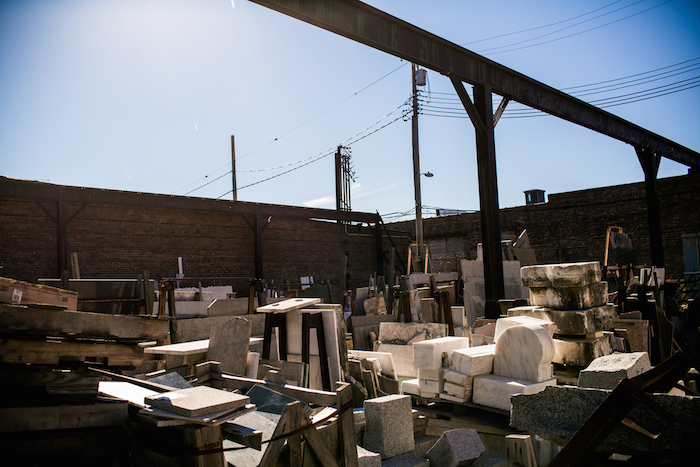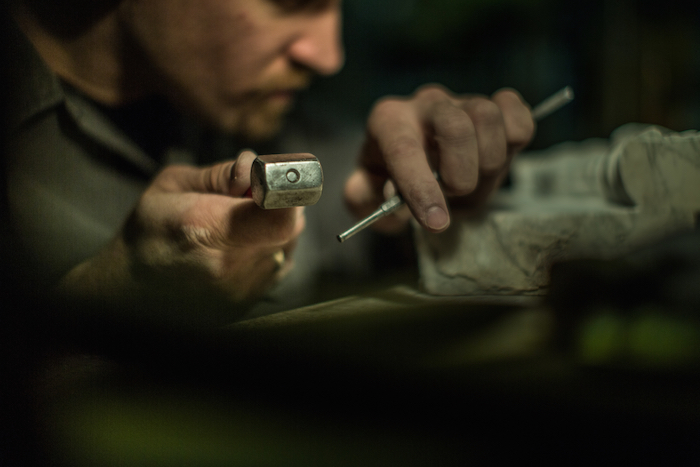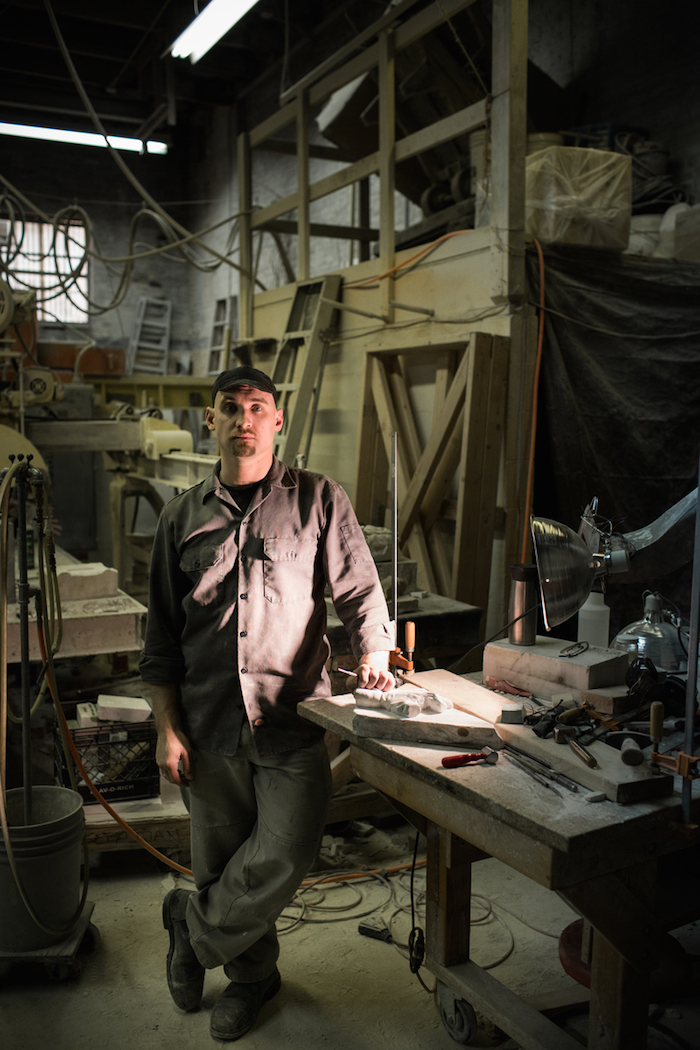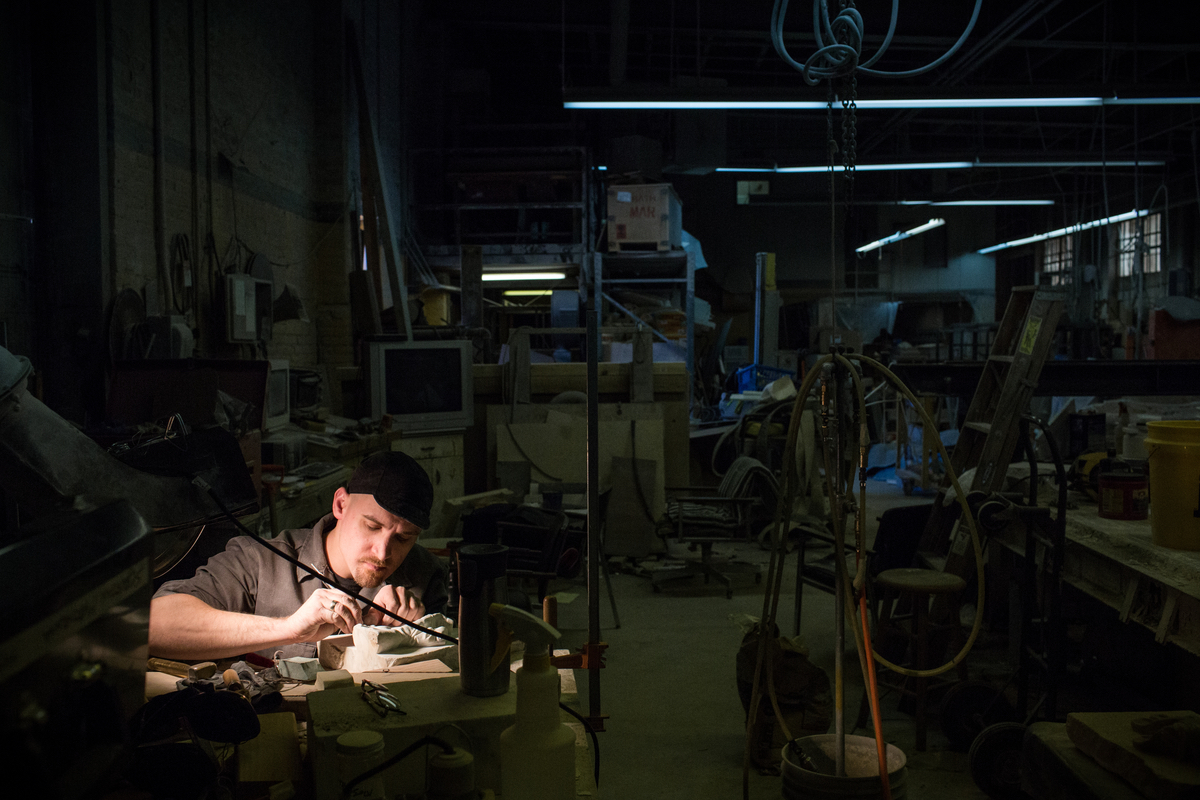CO: Also there’s an inherent ‘concept’ in the medium as well. How does that work?
SM: Unfortunately, there are certainly those who are unable to see past the material; they are unable or unwilling to look for the concept behind the piece as a whole. This is disappointing when it happens. Stone sculpture as a genre has a lot of “s,baggage.” Viewers, especially those with a background in the art will bring a lot of their own preconceptions to the table.
On the occasions that my work has received negative reviews or reactions, in almost every instance it seems to be the viewer’s reaction to the material. If a viewers feeling is that marble sculpture is, by its very nature, traditional, old school, conservative, or over-done, then they are just not going to be into it. That’s not something I can or should even try to remedy. So I don’t worry about it. Though I’ll admit that I find it frustrating when it happens. Truly, I think negative critiques can be the most helpful to an artist, but not if they are just dismissive because of one aspect of the work. That is not helping anyone out.
CO: Agreed. It seems like marble has such a rich history and those associations could be powerful.
SM: One can work with the historical/cultural context of their chosen material. Stone (because of its natural properties) has conceptual baggage, due to it’s traditional use for memorials, which themselves have a natural association with death. But I feel those that would associate stone with being passé or over done as a medium are short sighted. Why stone as opposed to any other medium? I mean, you’ve never heard someone walk into a contemporary art show and say, “Oh man—painting… that is sooooo, like, 32,000 years ago… *sigh* how Upper-Paleolithic… “
If a viewer or critic has a negatively prejudicial association with stonework, then they are not going to like my work. Period. That said I personally have had a lot of luck with finding work, collectors and venues to show my art. Far more than I ever had any right to expect. So I really shouldn’t complain. One working in stone doesn’t have to succumb to its loaded history, or even react to it necessarily, but one should be aware of it.
CO: Who are your favorite sculptors? Who has inspired you?
SM: Well… I’m not going to say Michelangelo (I’m really more of a Bernini-man), but as a genre, I’d admit that I am generally attracted to sculpture that has some quality of realism or technical skill to its creation. There are other contemporary stone sculptors out there doing spectacular work that inspire and push me, like Fabio Viale and Peter Glenn Oakley. I just had the honor of being in a show in New York with three other working stone sculptors, Barbara Segal, Stephen Shaheen and Alasdair Thomson. That was quite an experience. It was the first time I’d really been in a show with other stone sculptors. To see their work in person and talk shop with them was outstanding. I think that all artists working in a similar theme or material can push and help each other to be better.
Though I do love the work of other carvers, like wood carvers Paul Kaptein and Gerhard Demetz, my personal preferences are not just material or process based. An image on the cover of Hi-Fructose of Beth Cavener’s work basically punched me in the face from the art mag section of a book store. I felt it! Her work is gorgeous! And though I am in awe of hyperrealist sculptors like Ron Mueck, Jamie Solomon and Patricia Piccinini, I like their work because they are playing with our conception of reality in a way that is so much more than simply Trompe-l’œil. My work is often referred to as that (trompe-l’œil) and I never really think if it that way. If someone looks at a piece of my marble work and doesn’t realize that it is stone, then I have probably failed.
CO: What about locally?
SM: Honestly, I’m probably most inspired/influenced by other artists I’ve actually met here in Baltimore. Specifically, I met some great sculptors during my time at Rinehart. I was just in a show at UNC Ashville with Jackson Martin. I consider myself to be a pretty details-oriented guy—but Jackson really takes craftsmanship to a whole new level. And not just in one medium either. He is constantly exploring different material because they are an integral part of the concept of his work, and he just kills it every time.
David Paige, who was a guest critic, has a similar ability to work with a handful of materials and not just excel at their handling, but each time he does something with them that is not only aesthetically spectacular, but also works conceptually with its physical nature and history in a way that works in concert with our understanding of that material.
Also, seems like whenever I talk with Chris LaVoie he is doing something different. Sometimes he’s experimenting with a material or method that he has never even tried before. He is an excellent welder and metal worker, but often he is working with materials for upcoming shows that he is jus tackling for the first time. And that fact actually informs the work that he is making. Those guys are far braver than myself. I’m still focusing primarily on one particular medium. I think that I know stone pretty well, but I’m still trying to figure it out. Probably, hopefully, I never will.


























